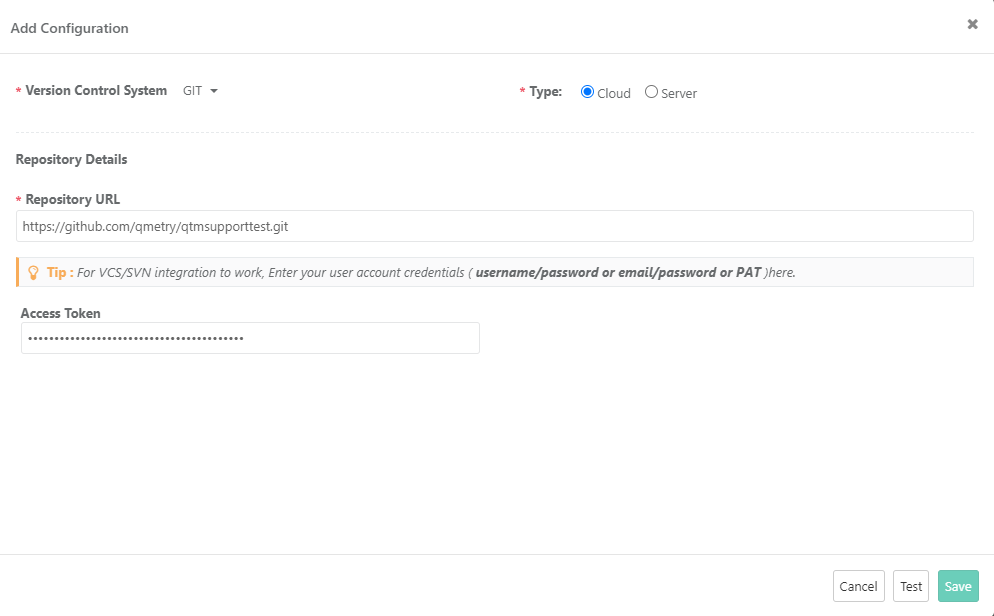toc
| Table of Contents |
|---|
Overview
Enterprise teams practicing Behavior-Driven Development (BDD) can author, store and sync features files directly to/from Version Control Systems (VCS) like SVN, Git, GitLab and BitBucket, using the built-in Gherkin editor in QMetry requirements. The two-way syncing between QMetry & VCS keep developers, testers and product owners up-to-date with the latest source code change commits with automated step definitions. Using QMetry automation agents, test executions could be triggered directly from QMetry. Test cases are smartly created/reused authored based on the feature step definitions and link them to requirements. Test Suite stores the automation execution results ensuring complete feature traceability with requirements.
...
3. Click on the + sign to add BDD Configuration.
4. The Add Configuration screen opens. Enter the following details on it:
- Version Control System: Select the version control system your organization is using as code repository.
- Type: The field appears on the screen when GIT/Bitbucket is selected as the Version Control System. Select the edition of the GIT/Bitbucket i.e. Cloud or Server.
Git Integration
- Repository URL: Enter the Repository URL for the version control system selected above. Enter Username and Password for the Repository.
...
- Follow these steps to generate access token for GitHub.
...
...
...
GitLab Integration
| Note |
|---|
QMetry supports Cloud version of GitLab Version Control System. |
The Add Configuration screen opens. Enter the following details on it:
...
Bitbucket Integration
| Note |
|---|
Bitbucket: QMetry supports Cloud and Server version of Bitbucket Version Control System. |
The Add Configuration screen opens. Enter the following details on it:
- Version Control System: Select BITBUCKET as the version control system your organization is using as code repository.
- Type: The field appears on the screen when GIT/Bitbucket is selected as the Version Control System. Select the edition of the GIT/Bitbucket i.e. Cloud or Server.
- Repository URL: Enter the cloned Repository URL for Bitbucket.
...
Gherkin editor is provided in the Requirements module. Test Scenarios for requirement are written in BDD code. Once the code is finalized, it can be pushed to GitHub/GitLab/Bitbucket/SVN for the use of automation testing. It combines requirements and corresponding scenarios at one place and reduces isolated communication with Automation Engineers. The shorter span of testing cycle enables development of high-quality product.
...
- Version Control: Version Control Systems configured for the Project populate for the field. Select the Version Control System you want to use for the requirement.
- Repository: Repository populates in accordance with the Version Control System selected above.
- Branch: Select branch based upon repository selection. You will be able to choose folder of respective branch. Branch access depends on the user through whom the BDD integration is done.
- Folder Path: Click on the Choose Folder to select the folder from the tree structure to store the BDD file. If folder path is not given, it will push it into root directory of repository.
...
- File Name: Enter the name (with file extension) of file that you want to pull/push from/to the repository. The File name should contain only characters, digit and "_" with a file extension. No other special characters and spaces are allowed in the file name. Now QMetry also supports files generated through BDD code in QAS (i.e. one with .bdd extension).
- Notify Automation Engineer: Select users to whom notification for BDD update details should be sent. By default all the users which are currently on Watchers list for the requirement will be automatically selected. You can select other users of the current project. Thus, multiple users can be notified while pushing BDD modifications to Version Control System.
- Comment: Enter Comments related to the file. It is mandatory when you are pushing the code to repository.
...
The BDD panel will be available in Jira add-on for the issue types synced with "Requirement" in QMetry.Note: If requirements are imported from Jira, then users can not edit the BDD code in QMetry. To edit the code, the requirement should be opened in QMetry Jira add-on.
Pre-requisites
- Install & Configure QMetry's Jira Integration Add-On
- Version Control System should be configured with the same QMetry Project with which Jira is configured
...
- Version Control: Version Control Systems configured for the Project populate for the field. Select the Version Control System you want to use for the requirement.
- Repository: Repository populates in accordance with the Version Control System selected above.
- Branch: Select branch based upon repository selection. You will be able to choose folder of respective branch. Branch access depends on the user through whom the BDD integration is done.
- File Name: Enter the name (with file extension) of file that you want to pull/push from/to the repository. The File name should contain only characters, digit and "_" with a file extension. No other special characters and spaces are allowed in the file name. Now QMetry also supports files generated through BDD code in QAS (i.e. one with .bdd extension).
- Folder Path: Click on the Choose Folder to select the folder from the tree structure to store the BDD file. If folder path is not given, it will push it into root directory of repository.
- Notify User: Select users to whom notification for BDD update details should be sent. By default all the users which are currently on Watchers list for the requirement will be automatically selected. You can select other users of the current project.
- Comment: Enter Comments related to the file. Mandatory for Push to Repository.
...



